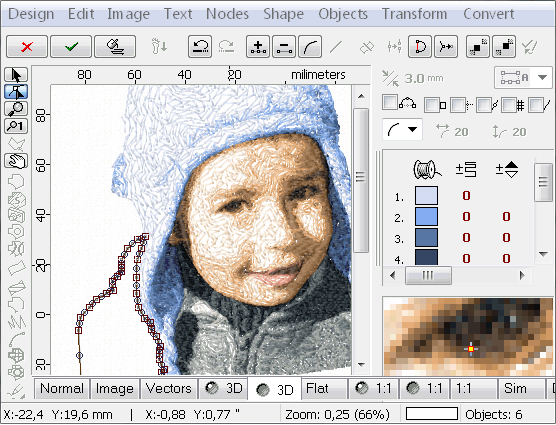Comprehensive Digitizing for Embroidery: From Layout to Sew
Comprehensive Digitizing for Embroidery: From Layout to Sew
Blog Article
Understanding the Embroidery Digitizing Process: Your Ultimate Overview
Needlework digitizing is a meticulous craft that requires precision and proficiency to translate detailed styles into electronic layouts for equipment needlework. As craftsmens start this journey to grasp the needlework digitizing process, a thorough understanding of the basics sets the foundation for quality. Nevertheless, beyond the basic understanding lies a realm of advanced software program, specialized devices, and nuanced techniques waiting to be discovered. By diving right into the subtleties of digitizing, one can unlock a globe of creative opportunities and elevate their needlework projects to brand-new heights.

Understanding Embroidery Digitizing Essentials
Needlework digitizing fundamentals create the structure whereupon detailed styles are translated into machine-readable layouts for exact stitching. This first action in the embroidery digitizing process is essential for making sure that the last stitched product is a devoted representation of the initial design. Comprehending needlework digitizing basics entails realizing key ideas such as stitch kinds, stitch direction, density, padding, and pull settlement.
Sew types play an important function in identifying the aesthetic and textural end result of the stitched style. By picking the ideal stitch kind, whether it be satin, fill, or running stitch, digitizers can attain the desired effect and improve the overall quality of the needlework. Furthermore, sew direction influences the flow and dimension of the design, while density figures out the spacing and protection of the stitches.
Moreover, rug sewing offers stability to the style by safeguarding the material and avoiding distortion during the embroidery process. Pull compensation is another necessary factor to consider to neutralize the all-natural propensity of fabric to contract when sewn. Grasping these needlework digitizing basics is fundamental for creating professional-quality stitched items.
Selecting the Right Digitizing Software Application
Selecting the appropriate digitizing software is an important choice that substantially affects the efficiency and high quality of the needlework digitizing process. Digitizing for Embroidery. When picking the appropriate digitizing software program, it is important to consider aspects such as the complexity of layouts you plan to create, the user-friendliness of the software application, the degree of client assistance provided, and the compatibility with your needlework device
There are various digitizing software application choices offered in the market, ranging from standard programs for novices to innovative software program for expert digitizers. Some popular options include Wilcom EmbroideryStudio, Hatch Needlework Software Program, and PulseID. These software use a large range of tools and functions to assist you create elaborate designs easily.
Prior to choosing, it is suggested to explore the different software application alternatives via free tests or demos to establish which one ideal matches your requirements. Furthermore, checking out reviews and looking for referrals from knowledgeable digitizers can offer valuable insights into the toughness and weak points of each software application bundle (Digitizing for Embroidery). By thoroughly reviewing your demands and comparing the features of various digitizing software program, you can make an enlightened option that improves your embroidery digitizing workflow
Digitizing Devices and Methods

Optimizing Layout Setup for Needlework
Grasping the complexities of style settings is fundamental in achieving optimal lead to the embroidery digitizing procedure, building upon the structure laid by recognizing digitizing tools and techniques. When enhancing design setups for embroidery, it is vital to consider elements such as stitch type, thickness, padding, pull compensation, and registration. Stitch type selection influences the general look and feel of the design, with choices recommended you read like satin, fill, and running stitches supplying various structures and results. Thickness refers to the spacing and thickness of stitches, impacting the design's protection and longevity. Appropriate underlay stitching provides stability and prevents material distortion, particularly for complicated layouts or on elastic materials. Draw settlement readjusts for fabric stretch during sewing, making sure exact style duplication. Enrollment setups straighten different elements of the layout accurately, keeping total design integrity. By fine-tuning these layout setups, embroiderers can improve the quality and precision of their embroidered developments.

Troubleshooting Common Digitizing Issues
When experiencing typical digitizing problems during the embroidery process, it is vital to recognize the origin triggers and carry out effective remedies without delay. One typical issue is stitch thickness concerns, where stitches might be also thick, causing the material to pucker, or also sporadic, resulting in gaps in the design. Readjusting the stitch thickness settings in the digitizing software program can aid settle this problem.
One more constant difficulty is thread breaks throughout the needlework process. This can take place due to different reasons such as wrong tension setups, boring needles, or utilizing low-grade string. Making certain proper maintenance of the needlework device, including routine needle adjustments and tension changes, can decrease the event of string breaks.
Additionally, design enrollment errors can lead to misaligned elements within the needlework design. Checking the design alignment in the digitizing software application and making necessary modifications prior to stitching can help in preventing this problem. By resolving these common digitizing problems promptly and efficiently, you can ensure a smoother needlework procedure and high-quality ended up products.
Final Thought
Finally, mastering the embroidery digitizing procedure needs a solid understanding of the essentials, the ideal choice of software program, and expertise of tools and strategies. Optimizing design settings and fixing typical digitizing issues are critical action in making certain premium embroidery results. By adhering to these actions vigilantly, one can accomplish accuracy and effectiveness in the digitizing process.
Report this page